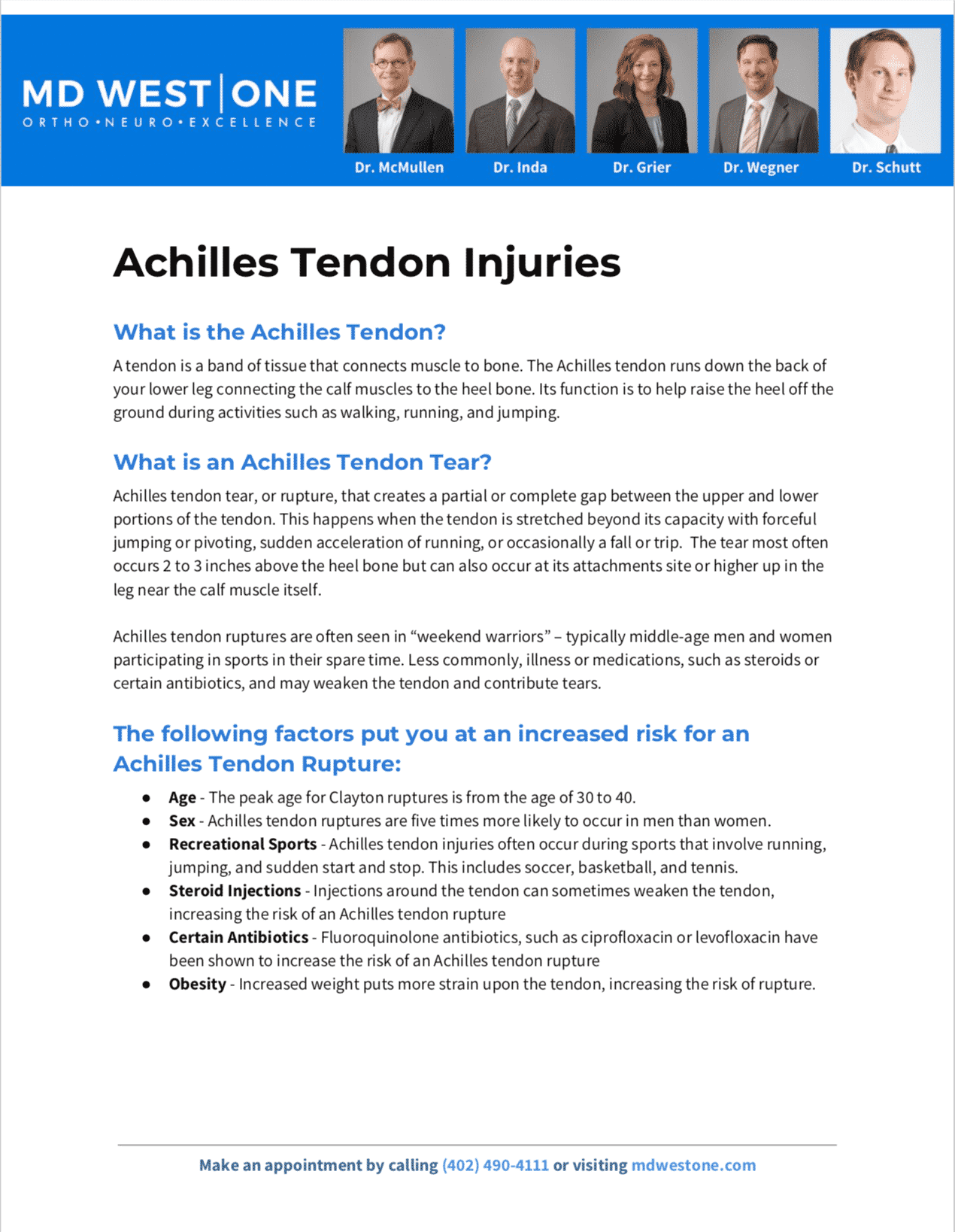Are you suffering from potential Foot & Ankle Stress Fractures?
The Omaha Foot & Ankle Specialists at MD West ONE are able to properly diagnose and treat foot & ankle stress fractures through both surgical and non-surgical treatments. If you have the following symptoms, you may want to make an appointment with one of our Board Certified Specialists.
- Pain, swelling, or aching at the site of fracture
- Tenderness or “pinpoint pain” when touched on the bone
- Pain that begins after starting an activity and then resolves with rest
- Pain that is present throughout the activity and does not go away after the activity has ended
- Pain which occurs while at rest, during normal activity, or with everyday walking
- Pain which is worse with hopping on one leg or an inability to shift weight/hop on affected leg/foot
If a stress fracture is not treated at an early stage (stress reaction), the pain can become severe. There is also a risk that the fracture may become displaced (the fractured bone moves out of normal alignment). Certain stress fractures (hip) are considered “high risk” stress fractures because they may have a poor outcome (such as needing surgery) if not identified early.
Meet MD West ONE's foot and ankle specialists and learn more about how they treat foot & ankle stress fractures.
Foot & Ankle Stress Fracture Causes, Treatments & Surgery
What are Foot & Ankle Stress Fractures?
A stress reaction can be considered similar to a deep bone bruise, which arises from trauma or overuse. Stress injuries can be classified on a spectrum upon diagnosis: early (stress reaction) or late (stress fracture). A stress reaction that goes untreated will develop into a stress fracture. In a stress fracture, a small crack develops from repetitive trauma, which is usually caused by overuse. Overuse injuries account for almost 50% of all sport injuries.
The following factors put you at an increased risk for a Foot & Ankle Stress Fracture:
Risk factors for stress fractures can be divided into two basic categories: extrinsic and intrinsic.
Extrinsic factors happen outside of the body. These can also be called environmental (nature) factors. These factors can include:
- Practicing incorrect training or sport technique.
- Having too rapid of a training program or volume of activity or changing your activity level without a gradual break-in period.
- Changing the surface you exercise on, such as going from a soft surface (like an indoor track) to outside on gravel or concrete.
- Running on a track or road with sloped surface.
- Using poor equipment or improper footwear (shoes that are too worn out, too flimsy or too stiff).
- Doing repetitive activity in certain high-impact sports, such as:
- Long-distance running (tibia, hip)
- Basketball
- Tennis
- Track and field
- Gymnastics (wrist stress fractures from weight bearing on hands/wrists, low back)
- Dance (feet, low back)
- Having a poor diet that has inadequate caloric intake for volume of sport.
- Having a low vitamin D level.
- Experiencing early specialization in sports. Youth who play one sport year-round without a break are at risk of stress fractures.
Intrinsic factors are things that are related to the athlete or patient and are not impacted by outside forces. These factors can include:
- Age: Older athletes may have underlying bone density issues such as osteoporosis. Already weakened bone will develop a stress reaction and/or fracture sooner than healthy bone.
- Weight: Both ends of the spectrum seem to be at risk for stress injuries. Someone with a low BMI or underweight individual may have weakened bones and someone with a high BMI doing repetitive loading with their body weight would also be at risk for injuries.
- Anatomy: Foot problems can affect the way the foot strikes the ground. These foot problems can include bunions, blisters, tendonitis, and low or high arches. Muscle weakness, imbalances or lack of flexibility can also be a factor.
- Sex: Females may be at risk if they have irregular menstrual periods or no periods.
- Medical conditions: Osteoporosis or other diseases that weaken bone strength and density (thickness). The weak or soft bones may not be able to handle the changes in activity.
Ways to Decrease Your Risk of Developing Foot & Ankle Stress Fractures:
- Once you feel pain, stop exercising. Only return to exercise if you are pain-free.
- See your doctor as soon as possible if you have a persistent area of concern or discomfort.
- Use the correct sports equipment.
- Wear the proper running shoes. Running shoes should be replaced every 300 miles.
- Add new physical activities (for example, switch running with swimming).
- Start new sports activities slowly and gradually increase the time, speed, and distance.
- When restarting a sport or activity, reduce your intensity by 50%. Follow the 10% rule — no increases of more than 10% per week.
- Make sure to properly warm up and cool down before activities.
- Practice strength training to help prevent early muscle fatigue, and to help prevent the loss of bone density that comes with aging.
- Follow a healthy diet full of calcium and vitamin D foods that will keep your bones strong. A sports nutritionist can be helpful if you are extremely active and have a history of stress fractures.
- If you decide to increase your activity level, ask your doctor for a recommendation of how much to add and when to add it.
- Optimize your bone health. If you have a known history of osteopenia or osteoporosis, discuss with your doctor how to medically manage these conditions. For an active person, treatment is best before an injury occurs. A stress fracture with a weak bone is harder to heal.
- If pain or swelling returns, stop the activity and rest for a few days. If pain continues, see your doctor.
- Check with your doctor before starting an exercise program or before taking a job that will involve a higher level of physical activity than you are used to.
- Follow all the rules your doctor gives you.
DIAGNOSIS
Your doctor may need to do several tests to see if you have a stress fracture and the severity of the fracture. These tests can include:
- Physical examination: During your first visit, your doctor will do a physical exam and discuss your risk factors for developing a stress fracture. When discussing risk factors, you will be asked about:
- Your medical history.
- Your work.
- Your activities.
- Any medications you might be taking.
- X-Rays: Your doctor may order an X-Ray to look for a fracture. However, a stress fracture can be difficult to see on an X-Ray because the bone often appears normal and the small cracks can’t be seen on the image. X-rays actually miss about ⅔ of stress fractures. X-Rays may not help diagnose a stress fracture unless it has started to heal. When the bone starts to heal, it creates a callus, or lump, that can be seen on X-Rays. With a high index of suspicion for a stress fracture, your doctor may recommend an imaging test that is more sensitive than an X-Ray and will pick up a stress reaction even before it may become a stress fracture. These tests can include:
- Magnetic resonance imaging (MRI).
- Bone Scan.
- Bone scan: A bone scan may be used to see stress fractures that cannot be seen on an X-Ray. During a bone scan, a tracer (a radioactive substance) is injected into your bloodstream. The tracer collects in the bone and settles in the areas where the bone is being repaired. The area that is affected by a stress fracture will appear darker on the bone scan that an uninjured area.
- Magnetic resonance imaging (MRI): When your doctor needs very detailed images of the injury, an MRI may be used. Magnetic resonance imaging (MRI) is a test that uses a large magnet, radio waves and a computer to produce very clear images of the human body. An MRI is preferred in many cases because:
- There is no radiation exposure.
- It takes less time than other imaging tests.
- It is better at diagnosing different types of bone and or soft tissue problem.
NON-SURGICAL TREATMENT OPTIONS
Stress fractures are treated in several ways. Your doctor will discuss your options based on the location and severity of your fracture. Also, your provider will aim to treat any risk factors you have for future injuries.
Treatments your doctor may recommend can include:
- Stopping the activity that is causing pain. Stress fractures happen because of repetitive stress and overuse, so it is important to avoid the activity that led to the fracture.
- Applying an ice pack (10 minutes) or ice massage (ice cube rub for three to five minutes) to the injured area.
- Resting for roughly two to eight weeks.
- Cross training by doing non-impact exercise (like a using a pool or bike) after discussion with your doctor may be allowed. Eventually, once you can perform low-impact activities for extended periods without pain, you can start doing high-impact exercises. Often, physical therapy can be very helpful in returning to activities and making adjustments to avoid reinjury.
- Adjusting your position if there is swelling in your leg, ankle, or foot. You can lessen the swelling by elevating your leg — raising your foot above the level of your heart — while you are lying on your back.
- Taking nonsteroidal anti-inflammatory medicines to help relieve pain and swelling.
- Using protective footwear to reduce stress on your foot or leg. This may be stiff-soled shoe, a wooden-soled sandal, or a post-op shoe which has a rigid sole.
- Using crutches to keep weight off your foot or leg until the bone heals.
SURGICAL TREATMENT OPTIONS
Some stress fractures need surgery to heal properly. This is called internal fixation. Depending on the location of fracture, the surgeon may use pins, screws, or metal plates.
POST-OPERATIVE RECOVERY
When you are recovering from a stress fracture, it is important to follow your doctor’s instructions. Ignoring your recovery plan and returning to your full activities too quickly can lead to more severe injuries in the future. There are two things to remember when you are starting to exercise again:
- Take it slowly.
- Introduce activities that place less stress on the injury.
During the early phase of healing, the doctor may recommend that you change your schedule so that you rest one day, do an activity the next day and then rest the next day. An example of this schedule is:
- Rest one day.
- Do an activity the next day.
- Rest the next day.
Alternating your activity and rest days allow your body to ease back into fitness. You should slowly increase how often and how vigorously you exercise. If the activity that caused the stress fracture is started too quickly, you may develop a larger fracture that is harder to heal. If you re-injure the bone, it can lead to long-term problems, and the stress fracture might never heal properly.
As long as you can feel pain, the bone is still fragile in that area, and could break again in the same place. It takes roughly six to eight weeks for a stress fracture to heal, so it is important to stop the activities that caused the stress fracture. Always ask your doctor before you fully return back to exercise to make sure the area is healed and you are ready to go.
Frequently Asked Questions?
Where do stress fractures happen?
Stress fractures can occur anywhere there is overuse, but they are most commonly found in the lower extremity as a result of impact and weight bearing activities. The most common bone is the shin bone or tibia (20% to 75% of all stress fractures - often running injuries). Stress fractures can also occur in the foot. The foot is made up of several small bones. The bones running to the toes are called metatarsals. There are five metatarsals in each foot. It is most common for a stress fracture to happen in the second and third metatarsals. Stress fractures can also be seen in the heel (calcaneus), hip (proximal femur) and even the lower back.
If a stress fracture is not treated, the fracture may get worse. It can heal improperly, lead to arthritis or may even need surgery. Definitely do not ignore the pain. Ignoring the pain can lead to serious problems in the future, so it is important to see your doctor when you start feeling the pain.
If you have an underlying medical condition like diabetes or neuropathy, it is very important to see your doctor if you are experiencing any pain with your legs, ankles or feet.
Will I need a cast if I have a stress fracture?
Your doctor may need to put a cast or fracture boot on your foot to keep the bones in a fixed position. Using a cast or boot help remove the stress on the leg and promote healing.
AMERICAN ORTHOPAEDIC FOOT & ANKLE SOCIETY
All of the foot and ankle surgeons in the practice are recognized members of the American Orthopaedic Foot & Ankle Society. It is the oldest and most prestigious medical society dedicated to the foot and ankle. The mission of the society is to advance science and practice of foot and ankle surgery through education, research, and advocacy on behalf of patients and practitioners. These physicians dedicate their time and energy to improving the patient experience and their knowledge in their field. For more information visit http://www.aofas.org.
MD West ONE Foot & Ankle Specialists:
The Foot & Ankle Specialists are all Board Certified and Fellowship-Trained, meaning they’ve focused their education, training and research on orthopaedic surgery of the foot and ankle.





